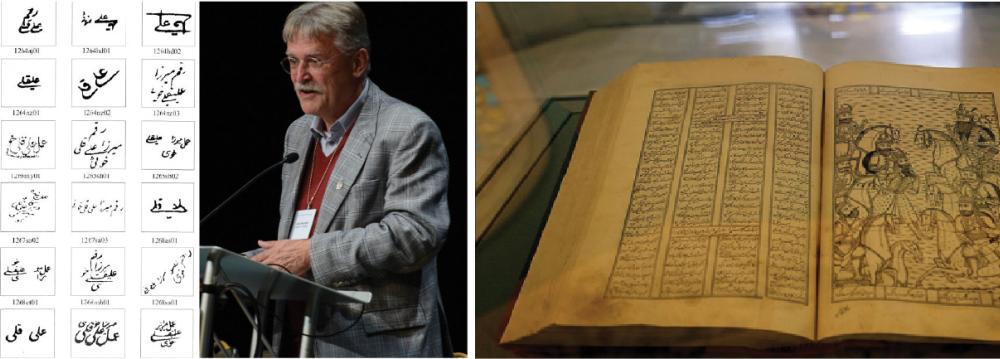German researcher Ulrich Marzolph, who has devoted half his life to Iranian literature and folklore, will speak in Tehran about a valuable lithograph.
Marzolph’s lecture is planned for Tuesday, May 9, from 3-5 pm at Malek Library Museum, on the occasion of National Ferdowsi Day (May 15), a day to commemorate the celebrated Persian poet Abolqasem Ferdowsi (940-1020), IBNA reported.
The lecture is on Ferdowsi’s magnum opus, Shahnameh (Book of Kings), the world’s longest epic poem created by a single poet.
The expert in eastern and Islamic studies and Persian narrative tradition “will talk about a very special lithograph of Shahnameh.”
The lithograph to be discussed is that of Mirza Ali Qoli Khui (who lived in the 19th century), Qajar master of Persian lithograph illustration. It has been a while since the illustrator came to Marzolph’s attention. Marzolph, 64, whose PhD dissertation in 1981 is a typology of Persian folktales, has extensively studied the life and works of Khui.
He traced Khui in over 30 titles by searching for his signatures, captions and added descriptions. In an analytical comparison, Marzolph has found that the artist deliberately left behind different signatures.
At a meeting in Tehran in May 2014 at Iranian Artists Forum, Marzolph enumerated some typological traits in Khui’s editions, including attention to detail, decorativeness, focus on expressions and emotions in human figures and various polarities between beauty and ugliness, youth and old age and so on.
The upcoming event on Khui’s edition of the Shahnameh will also be attended by Iranian illustrator and codicologist Ali Bouzari, 39. He will explain some technical details about the edition which is the earliest lithographic Shahnameh existing in Tehran.
Published in November 1850, the 595-page work in Nastaliq calligraphy script contains 56 illustrations that have attracted many scholars and researchers.
In 2001, Marzolph completed the book ‘Narrative Illustration in Persian Lithographed Books,’ a work frequently referred to by those who study Khui and his works.
One Master, Many Signatures
In an essay titled ‘Mirza Ali-Qoli Xu’i (Khui) Master of Persian Lithograph Illustration,’ dedicated to British art scholar and author Basil Robinson (1912-2005), Marzolph mentions an 1848 edition of ‘Khamsa,’ a collection of five long narrative poems by Persian poet Nizami Ganjavi (1141-1209), illustrated by Khui. He quotes Robinson, referring to it as “the most lavishly decorated Persian book ever produced in lithograph print. He evaluated the illustrator Mirza Ali Qoli Khui as a prolific artist, and praised the publication as the most individual and endearing of all Persian lithographed books.”
According to Marzolph’s essay, “it can be guessed that in his early days, Mirza Ali Qoli worked in Tabriz where the first lithograph printing presses had been established … Soon after the beginning of Nasser al-Din Shah’s reign, he appears to have followed the court to Tehran.
In an 1851 edition of Persian poet Saadi’s ‘Kolliat,’ he calls himself ‘bande-ye dargah’ (in Persian: servant of the court). In an 1853-57 edition of ‘Rowzat al-Safa,’ a biographical collection by Persian historian Mir-Khand (1433-1498), Khui signs as ‘khadem (servant) of Dar-al-Fonun,’ the first institute of higher learning in Iran founded in 1851, and also qualifies himself as painter.”
The particular Shahnameh that forms the subject of the talk is the first illustrated Iranian edition of the Persian national epic. It has already been listed as Khui’s work by Robinson.
Marzolph describes Khui’s work in the essay: “Ali Qoli takes great care in the highly stylized, minute representation of faces, especially the hair and beard. Exposed teeth and stuck-out tongues are often rendered in extreme detail to illustrate torment as well as imminent or actual death.
The background in his landscape illustrations is sometimes filled with silhouettes of tiny flying birds, often no more than a simple cross of slightly bent lines.”
At the end of the essay, Marzolph says that the illustrations such as Khui’s works “offer the charming naivety of an art that, given the hundreds of copies in which it was reproduced, was a little closer to people (compared to manuscript illuminations prepared for Timurid princes). This popular aspect might contribute, in the long run, to an adequate understanding of the Persian art of bookmaking in the Qajar period (1785-1925).”
Malek Library Museum is located on United Nations Street, Imam Khomeini Square.


